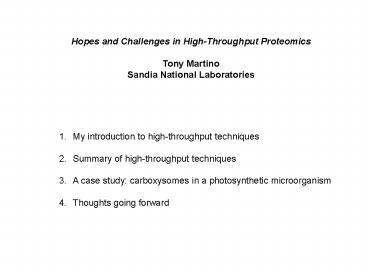Hopes and Challenges in HighThroughput Proteomics - PowerPoint PPT Presentation
1 / 22
Title:
Hopes and Challenges in HighThroughput Proteomics
Description:
Lockhart et at., Nature (2000) (2) MGC: full-length cDNA resources ... TX-100. Transmission Electron Micrographs of Carboxysomes ... – PowerPoint PPT presentation
Number of Views:91
Avg rating:3.0/5.0
Title: Hopes and Challenges in HighThroughput Proteomics
1
Hopes and Challenges in High-Throughput
Proteomics Tony Martino Sandia National
Laboratories
- My introduction to high-throughput techniques
- Summary of high-throughput techniques
- A case study carboxysomes in a photosynthetic
microorganism - Thoughts going forward
2
EMSA of Cyclin D2 Promoter, 1227-1168 an Sp1 and
STAT5 Enhancer Site on the Cyclin D2 Promoter
Martino et al., J. of Immunology, 2001.
3
Computational Gene Annotation
Phylogenetic Profiles
Correlated Gene Neighbors
- ORF searches
- Codon usage statistics
- Higher-order statistics
- Models for specific signals
- Hidden Markov models
observed gene locations
inferred functional linkage
Rosetta Stone Method
Rosetta Stone in organism 1 Protein A in
organism 2 Protein B in organism 2
Marcotte et al., Nature (1999) Eisenberg et al.,
Nature (2000) Shoemaker et al., Nature (2001)
4
Experimental Gene Annotation
(1) Clustering of expression data
Strausberg et al., Science (1999)
Challenges (i) rare transcripts (ii)
long transcripts (iii) difficult structures
Shoemaker et al., Nature (2001) Lockhart et at.,
Nature (2000)
5
The Role of Proteomics
- The existence of an ORF does not imply the
existence - of a functional gene.
- Limitations of comparative genomics.
- mRNA levels may not correlate with protein
levels. - Protein modifications ? post-transcriptional
modifications, - isoforms, post-translational modifications,
mutants. - Issues of proteolysis, sequestration, etc.
relevant only at - the protein level.
- Protein complex composition, protein-protein
interactions, structures. -
Pandey et al., Nature (2000)
6
Mass-Spectrometry Protein Identifications
(1) Protein preparations and separations
capillary and microfluidics techniques.
(2) Mass Spectrometry
trypsin digest
differential display
MALDI
peptide mass fingerprint matched
against predicted peptide databases
immunoprecipitation
ESI MS-MS
after phosphatase
peptide sequence tag searched against nucleotide
and protein sequence databases
de-novo sequence predictions
7
Protein-Protein Interactions
(1) Affinity Purification
(3) Yeast 2-hybrid
(2) Phage Display
affinity support
no interaction
tag
protease cleavage
positive interaction
transcription
PAGE
MS
Protein Chips
GST-fusion proteins
ORF-activation domain fusion
GST-fusion proteins
ORF-binding domain fusion
phage cDNA display library
cell lysate
wash unbound proteins wash unbound proteins
nutritional selection
elute bound proteins amplify phage particles
grow up surviving yeast colonies
MS repeat and/or sequence
repeat and/or sequence
8
High-Throughput Proteomics
- Functional organization of the yeast proteome
by systematic analysis of - protein complexes. Gavin et al., Nature
(2002) - A comprehensive two-hybrid analysis to explore
the yeast protein interactome. - Ito et al., PNAS (2001)
- A comprehensive analysis of protein-protein
interactions in Saccharomyces - cerevisiae. Uetz et al., Nature (2001)
- Systematic identification of protein complexes
in Saccharomyces cerevisiae - by mass spectrometry. Ho et al., Nature
(2002) - Global Analysis of Protein Activities Using
Proteome Chips. - Zhu et al., Science (2001)
9
GenomicsGTL Problem Statement
10
Experimental Elucidation of Molecular Machines
Regulatory Networks in Synechococcus Sp.
Carbon Fixation
Imaging
Proteomics
2.4 Mb genome 2500 orfs
Interactomics 2-hybrid Phage display Pulldowns/
IPs Genetic tags NMR
11
Carbon Concentrating Mechanism (CCM)
Kaplan et al., Annu. Rev. Plant Physiol. Plant
Mol. Biol. (1999)
12
Carboxysome Isolation
cleared whole cell lysates
MgSO4
cleared whole cell lysates
TX-100
ANALYSIS
13
Transmission Electron Micrographs of Carboxysomes
14
Western Blot Analysis of Cell Lysates and
Particulate Fractions
cso operon
15
Mass Spec-Based Analysis of Soluble and
Particulate Fractions
?6
?7
16
Mass Spec-Based Analysis of Soluble and
Particulate Fractions
17
Mass Spec-Based Analysis of Soluble and
Particulate Fractions
18
Binary Protein Interactions with the
Carboxysome Bacterial Two-Hybrid Analysis
MS evidence for presence in Syn8102.
19
Phage Display Rubisco Small Subunit (rbcS)
Panning Against PhD 12 Peptide Library
6 colonies from 3rd panning of phage displayed
PhD12 library against rbcS were sequenced, the
consensus sequence is PFP
FHWRYWYPPFPS TMGFTAPRFPHY (2) WHRTPVRWLETW HLNILS
TLWKYR QTARLQAPLAQN
20
Eight Proteins in SynWH8102 Have PFP
SYNW1032 dnaE DNA polymerase III, alpha
subunit SYNW0193 putative multidrug efflux
ABC transporter SYNW0394 putative
N-acetylneuraminic acid synthetase SYNW1420
conserved hypothetical protein SYNW0455
possible glycosyltransferase SYNW0958 similar
to leukotoxin secretion protein SYNW1908
possible Zn-dependent metalloprotease SYNW2018
hypothetical
21
Conclusions for Carboxysome Work
- First carboxysome separation from open ocean
cyanobacteria - Biochemical links b/t RbcL, RbcS, CsoS1, and
CsoS2 and the carboxysome - Association of b-CA with the carboxysome
- First biochemical evidence OrfA is associated
with the carboxysome - Synechococcus WH8102 is insensitive to CO2 within
range of 100 to 750 ppm of CO2 - Putative TPR and rbcS binding ligands
22
My Thoughts on Hopes and Challenges
- Whole proteome characterization is a huge
expensive effort that is a little disorganized
right now. - Complementary techniques will always be required.
- In the near term, high-throughput proteomic
techniques will be a discovery-based platform a
way to find interesting questions not necessarily
answers. The answers will come from confirmatory
reductionist classical biology experiments.































